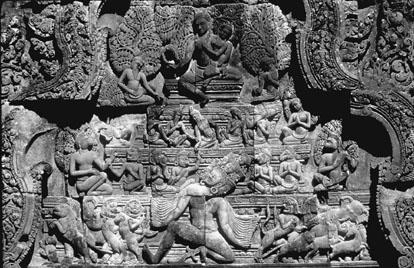

 | Page 245 |  |
northeast Thailand, north into Laos, east into Vietnam, and south into the Mekong Delta. Within the Angkor region many scholars used inscriptions, architectural and sculptural analysis, and (to a lesser degree) archaeological work to establish a chronology of the monuments. Most notable among these scholars were Georges Coedès, Jean Boisselier, and Pierre Dupont. By the time that France gave judicial powers and technical responsibilities to countries in its former colony in 1951, EFEO had identified 1,256 monuments: 780 in Cambodia, 401 in Vietnam, and 75 in Laos.

Bas relief from the Temple of Angkor depicting gods
(Gamma)
Although much effort was devoted to developing the time and space systematics of Angkor, some EFEO archaeological research also explored politics and economics in the Khmer Empire. Victor Goloubew’s pioneering use of aerial photography in the 1930s identified road networks radiating out from Angkor and mapped the limits of the expansion by Jayavarman VII, the last of the great Khmer kings, in the twelfth and thirteenth centuries. In 1979 Bernard-Philippe Groslier’s “hydraulic city” model, using agricultural and hydrological systems visible in aerial photographs, suggested demographic and ecological limits of the system and reasons for its ultimate demise.
A second focus of EFEO research was the documentation of the pre-Angkorian period of Cambodia and the ancient kingdom of Champa in Vietnam. Henri Parmentier’s Cham project, from 1900 to 1904, centered on brick monuments in Cambodia and Vietnam. He contended that many were Cham, but others (and particularly those in the Mekong Delta) represented a pre-Angkorian architectural tradition. Georges Trouvé’s conservation efforts at the site of Ak Yom from 1932 to 1935 revealed that the earliest construction of the monument occurred during the seventh century a.d. In 1936 Victor Goloubew used aerial photographic techniques to study the pre-Angkorian site of Banteay Prei Nokor. Such work on the pre-Angkorian period greatly piqued other scholars’ interest in that era, which they pursued throughout Indochina.
Systematic archaeological excavations gained importance in the 1940s. From 1942 to 1945 Malleret investigated the pre-Angkorian “Funan” occupation of the Mekong Delta in his excavations
 |  |